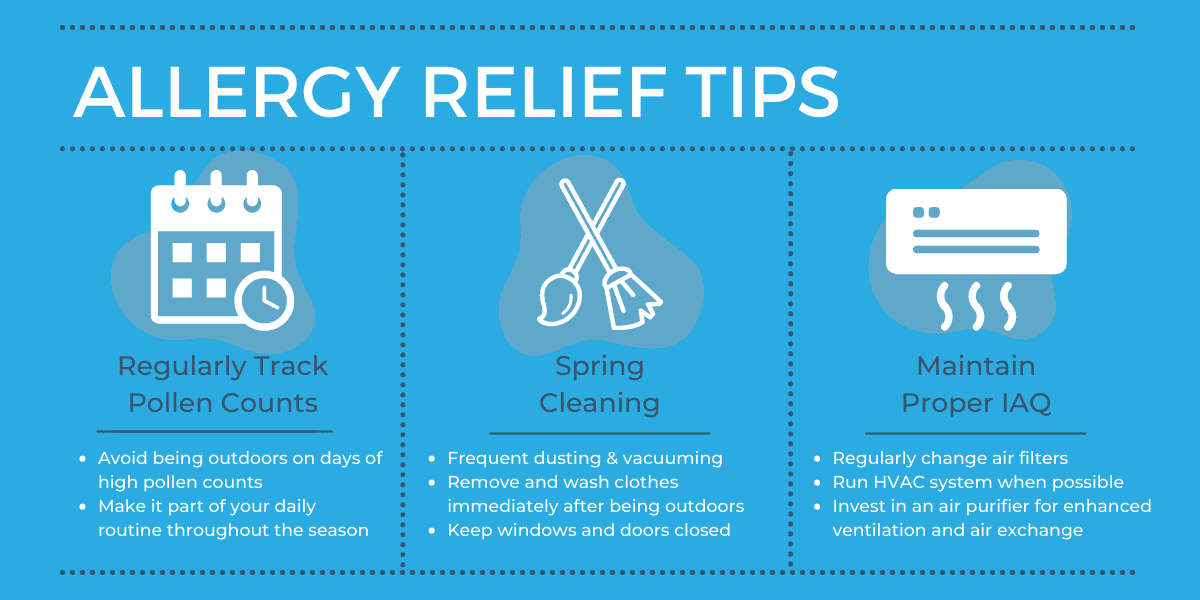How to Cope with Spring Allergies
How to Cope with Spring Allergies
Spring is in the air! And consequentially, so is pollen. Allergy season is kickstarted by pollenating trees and flowering plants in the spring, prompting scratchy throats, itchy eyes, running noses, and congestion to name some common symptoms. These symptoms can really take the fun out of warmer weather and blooming nature as we shift from winter to spring.
Believe it or not, the quality of your indoor air can contribute greatly to your health and the degree of risk you are at in terms of allergy triggers. Knowing the quality of your indoor air, and recognizing ways to keep it in proper condition, can reduce these risks and promote a more symptom-free environment.
Find out more about common causes of spring allergies, their impact on your indoor air quality, and how to reduce their risks inside your home.
Common Causes of Spring Allergies
With the start of spring comes new blooms of trees, flowers, and grasses; their pollination releases tiny, light-weight pollen cells that are carried through the air by spring winds. These allergy triggers make their way into your nose and lungs, causing irritating allergic and asthma-related symptoms.
According to the American Academy of Allergy, Asthma, and Immunology, tree pollen is the primary trigger of seasonal allergies, with common culprits stemming from Cypress, Birch, Chestnut, Olive, and Poplar tree families; depending on what region you live in, specific types of trees bloom allergens in different areas. Grass pollen follows as another major springtime allergen. Blooming mold spores from yeast and mildew can also heighten allergy symptoms, as forms of outdoor mold like Hormodendrun, Alternaria, and Cladosporium can transport via wind from spring to fall season, along with the potential for indoor mold growth, as well.
What are the Symptoms?
Common symptoms associated with seasonal Allergic Rhinitis, known by most as Hay Fever, include the following:
- Sneezing and runny nose
- Nasal congestion
- Cough and wheezing
- Sore, scratchy throat
- Chest congestion
- Itchy, watery eyes
Why Do My Allergies Continue Indoors?
While these spring-induced allergies may form from outdoor sources, these pollen particles can easily find their way into your home through several different modes. With nicer weather rolling in, people are often more inclined to leave their doors and windows open; however, this exchange of outdoor and indoor air invites the pollutants directly inside. This outdoor exchange could also create increased humidity if windows are open and HVAC systems are shut off, which is where conditions become perfect for indoor mold allergens to grow. Pollen can also stick to your clothing or external belonging that have been outside and travel indoors when you enter your home.
Once the allergen particulates make their way inside, circulation of the air through air conditioning systems can trap these triggers, redirecting them in all areas of the house. This allows for continual irritation of allergy symptoms, especially when air is not being thoroughly filtered or ventilated. At this point, your indoor air quality is being compromised, but to what degree?
The Impact of Indoor Allergens
Indoor exposure to pollen and outdoor allergens is a form of indoor air pollution, usually prompting allergy symptoms to worsen in these confined spaces. Indoor air pollution stems from particulate matter such as pollen, mold, pet dander, household products, tobacco smoke, indoor gases, asbestos, and other harmful or irritating substances that get trapped in a recirculating area. This not only pollutes the air supply, but also prolongs the triggering of allergy symptoms and respiratory irritation as you constantly breath in the same contaminated air.
If you cannot find relief from this situation, your indoor space may suffer from poor ventilation or filtration of its air supply. This poor indoor air quality could be enhanced by older HVAC systems, inadequate filtration systems, or isolation from a central air unit, and your home may need further forms of remediation in order to improve its air quality.
Spring Allergy Relief: Ways to Stop the Symptoms
Allergies can become pretty unbearable if left untreated, so why not have a list of ways to relieve them and prevent their reoccurrence through the rest of spring season? Allergy medication is one of the most immediate remediations for those who suffer with spring allergies; whether prescribed or over the counter, keeping up with a regular allergy medicine throughout the season can significantly treat present symptoms and control their severity later on. Let’s check out a few more options that are more preventative tips for allergy-free living.

It is wise to consider investing in additional means of air filtration, especially during these spring months of heightened air pollutants. EnviroKlenz® offers their high-efficiency Air System Plus, a portable air purifier that utilized its earth-mineral technology within air cartridges, alongside HEPA filtration and UV-C bulbs, to enhance current air filtration and purification in indoor spaces. Adding one of these systems to your home can capture and remove pollen and mold allergens, along with other particulate matter, at a more efficient rate than an average HVAC system, which can improve the living conditions for allergy-prone members of the household. This further consideration for allergy relief can make all the difference in your IAQ and respiratory health, and this relief lasts throughout all seasons of the year!
UV Mobile Air System

✓ Patented earth mineral technology works to attack VOCs and break them down on a compound level
✓ No chemicals or masking agents

✓ Will not release any chemicals back into your environment
✓ UVC lamps are continuously shining on the collected organisms with high effeciency of kill and destruction
EnviroKlenz® Medical Disclaimer:
“Any information that is provided on this website is not for the use by any commercial or personal entity without expressed written consent of the blog author. The material and statements illustrated within this blog are not intended to diagnose, treat, cure, or prevent any diseases or medical conditions. Nor does the author in any way guarantee or validate the validity, totality, or efficacy of any claims and will therefore not be held responsible for the content of any claims. Always consult your medical physician for any specific medical advice or recommendations.”




Comments
Post a Comment